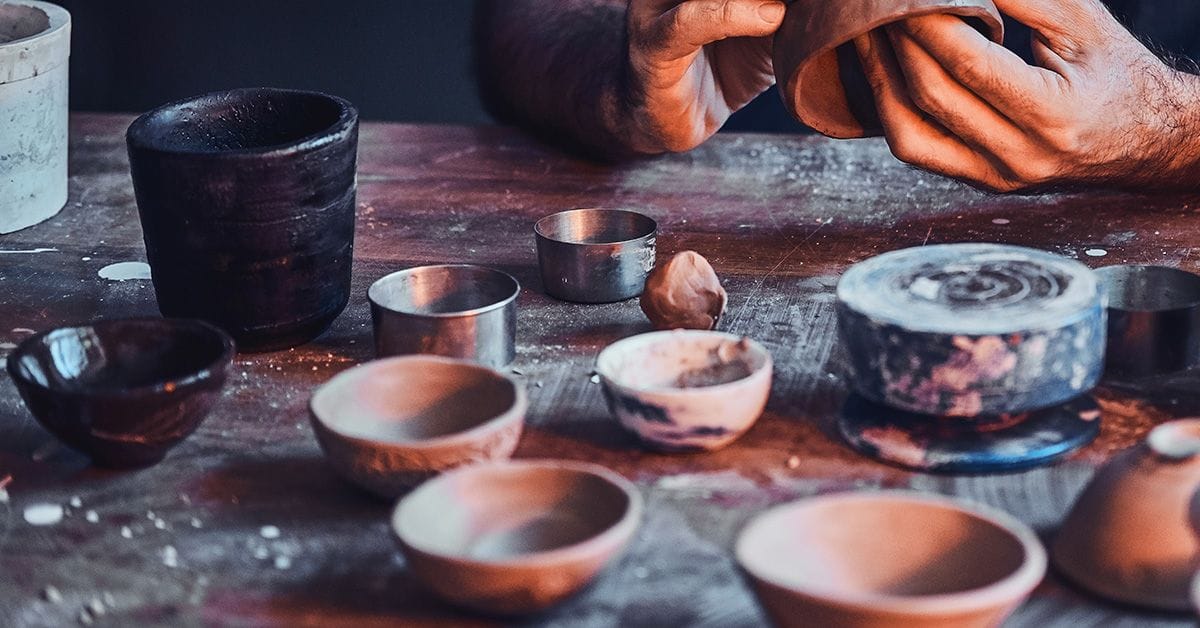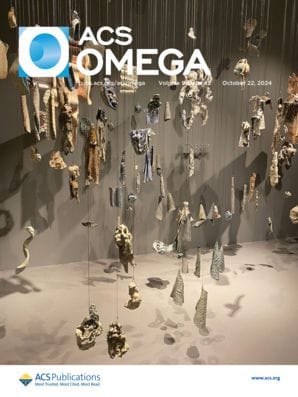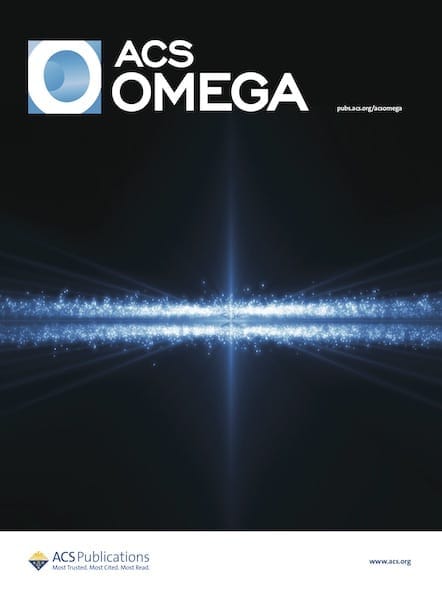Discover how scientists are merging art and science by incorporating graphene oxide into ceramics, enhancing both their mechanical properties and artistic potential.

Ceramics are non-metallic, inorganic, crystalline materials.1 They generally include compounds such as oxides, nitrides, carbides, and borides—and there are diverse applications for these materials in many industries including aerospace, communications, and electronics. Ceramics are also important in art, where the term is usually applied to forms fired from clay.
Earlier this year, we looked at new recipes to limit cobalt use in pottery glazes, but there is also scope to alter the recipe of the clay itself.
In new work published in ACS Omega, an interdisciplinary team in Singapore merged technology and science with artistic exploration to experiment with the production, properties, and application of a new kind of ceramic.2 The main focus was to incorporate graphene oxide into kaolin—a naturally occurring clay mineral—and explore how this changed the properties. Other work has previously found that adding graphene oxide into ceramic matrices inhibits cracking and enhances overall durability.3 It can also improve environmental stability, making ceramics more resistant to high temperatures and thermal shock.4,5

Art and Science of Reinforcing Ceramics with Graphene via Ultrasonication Mixing
DOI: 10.1021/acsomega.4c05748
In addition to incorporating graphene oxide, the team wanted to test out a high-intensity ultrasonication method—a technique that employs low-frequency sound waves to disperse and incorporate particles into solid matrices.6 Compared to traditional mixing of an additive through a clay slurry, this is a faster and more energy-efficient technique that allows simultaneous dispersion, mixing, and uniform distribution throughout the matrix.
To test the resulting mechanical properties, the team experimented with novel forms and textures in the resulting clay medium, working with artist Delia Prvački to evaluate the composite through tactile and visual means. The resulting scientific data and artistic creations were displayed in an exhibition entitled “Continuity, Persistence, Line: Thinking Through Clay,” which opened in August 2024 at the NUS Museum within the National University of Singapore's campus. The combination of ultrasonication and graphene oxide led to a kaolin preparation with enhanced mechanical properties, and also improved the processability and appearance of the material. The authors argue this collaborative work yields significant insights into the development and characterization of novel composites. The artistic perspective further enriches understanding of the materials beyond their scientific properties, engaging with various cultural and conceptual aspects.
The researchers were also chosen to have their research featured in a supplementary journal cover for ACS Omega, featured below. This selective program provides authors the opportunity to have their scientific artwork considered for use as a cover by the ACS journal publishing their research. Click here to download a high-res version of the cover.

Cover Description: This work highlights the convergence of art and science in the field of graphene reinforcement of ceramics through ultrasonication, exemplifying the synergy between materials engineering, advanced manufacturing, and artistic expression. An interdisciplinary collaboration, featured in an exhibition at the NUS Museum, underscores the value of integrating scientific research, technological innovation, and artistic exploration. This approach not only advances material performance but also aligns with the principles of a circular economy by promoting sustainable and creative applications in both industry and art.
Further Explorations: Graphene-Infused Materials
Beyond art, there are also real-world practical applications for graphene-oxide ceramics. Some have been shaped into 3D superhydrophobic structures with good mechanical strength and thermal stability, enabling them to deal with oil spills.7 The resulting ceramics demonstrated adsorption capacity up to 30 times greater than conventional inorganic sorbent materials, alongside compressive strength up to 270 times higher than graphene sponge-based sorbent materials. In addition to absorbing water and contaminants, porous graphene-based ceramics can be used to suck up sound and reduce noise pollution.8 This was achieved by coating porous ceramics with a film of graphene oxide and styrene-butadiene rubber. The researchers also used ultrasonication to obtain a homogeneous solution, after which they introduced the composites by vacuum impregnation and atmospheric vulcanization to optimize the internal pore structure. Subsequent tests found this material was good at reducing middle- and low-frequency noise.
Nanolaminated reduced graphene oxide ceramics have also been pressed into service as lightweight and mechanically reliable electromagnetic interference shielding applications.9 In this, parallel reduced graphene oxide sheets elevated the flexural strength by 110–130% and improved the fracture toughness by 100–130% compared with monolithic silica—feats achieved by capturing and deflecting propagating cracks.
Graphene oxide has also been incorporated into cement-based materials, where it appears to have a catalytic effect on the hydration process and plays a role in regulating the morphology of the hydration products. In turn, this affects the formation of the microstructure of cement-based materials. Analysis in ACS Sustainable Chemistry & Engineering describes how the oxygen-containing functional groups on the surface of graphene oxide can absorb a large number of water molecules.3 It also provides more nucleation sites, promoting the formation of hydration products and gradually transforming these linear rod-like products into polyhedral crystals. This work builds on the first experimental study to evaluate the influence of oxygen functional groups of graphene and defectiveness of graphene structures on the axial tension and compression properties of graphene–cement mortar composites—a piece published in ACS Applied Materials & Interfaces in 2017.10 In the earlier study, a series of reduced graphene oxide samples with different levels of oxygen groups were prepared by reducing graphene oxide using different concentrations of hydrazine and different reduction times and adding the resulting samples to cement mortar composites. The findings indicate a strong influence of the level of oxygen groups and crystallinity of graphene structures on the physiochemical and mechanical properties.
The interdisciplinary approach of merging art and science in ceramics has opened many new avenues for innovation and creativity. Taken together, these collaborative efforts highlight the potential of combining scientific rigor with artistic exploration to develop advanced materials that address both aesthetic and functional needs.
References
- What Are Ceramics? The American Ceramic Society 2024.
- Wu, J. et al. Art and Science of Reinforcing Ceramics with Graphene via Ultrasonication Mixing. ACS Omega 2024, 9, 42, 42944–42949.
- Fu, Q. et al. Catalysis and Regulation of Graphene Oxide on Hydration Properties and Microstructure of Cement-Based Materials. ACS Sustainable Chem. Eng. 2023, 11 (14), 5626–5643.
- Li, M. et al. High temperature properties of graphene oxide modified metakaolin based geopolymer paste. Cem. Concr. Compos. 2022, 125, 104318.
- Janjaroen, T. et al. The Mechanical and Thermal Properties of Cement CAST Mortar/Graphene Oxide Composites Materials. Int. J. Concr. Struct. Mater. 2022, 16 (1), 34.
- Meroni D, et al. Sonoprocessing: From Concepts to Large-Scale Reactors. Chem. Rev. 2022, 122 (3), 3219–3258.
- Bi, Y. et al. Lotus-Seedpod-Bioinspired 3D Superhydrophobic Diatomite Porous Ceramics Comodified by Graphene and Carbon Nanobelts. ACS Appl. Mater. Interfaces 2018, 10, 32, 27416–27423.
- He, C. et al. Enhanced Sound Absorption Properties of Ceramics with Graphene Oxide Composites. ACS Omega 2021, 6, 50, 34242–34249.
- Huang, Y. et al. Nanolaminated Reduced Graphene Oxide/Silica Ceramics for Lightweight and Mechanically Reliable Electromagnetic Interference Shielding Applications. ACS Appl. Mater. Interfaces 2020, 12, 49, 55148–55156.
- Gholampour, A. et al. From Graphene Oxide to Reduced Graphene Oxide: Impact on the Physiochemical and Mechanical Properties of Graphene–Cement Composites. ACS Appl. Mater. Interfaces 2017, 9, 49, 43275–43286.
